Hello, dear readers. I’m Dr. Candy Akers, and I’ve dedicated a significant portion of my veterinary career to understanding and treating various skin conditions in our beloved pets. Actually, seeing the cycle of skin diseases over and over again, made me look to holistic medicine. One of the most common, yet often misunderstood, conditions I come across is the presence of warts on dogs.
These small growths, while usually benign, can cause concern for many pet owners. Through this blog, I aim to shed light on the nature of dog warts, their causes, and the most effective treatments available.
My goal is to provide you with a comprehensive guide, backed by years of experience and research, to help you make informed decisions about your pet’s health. Let’s dive into the world of dog warts and demystify the concerns surrounding them.
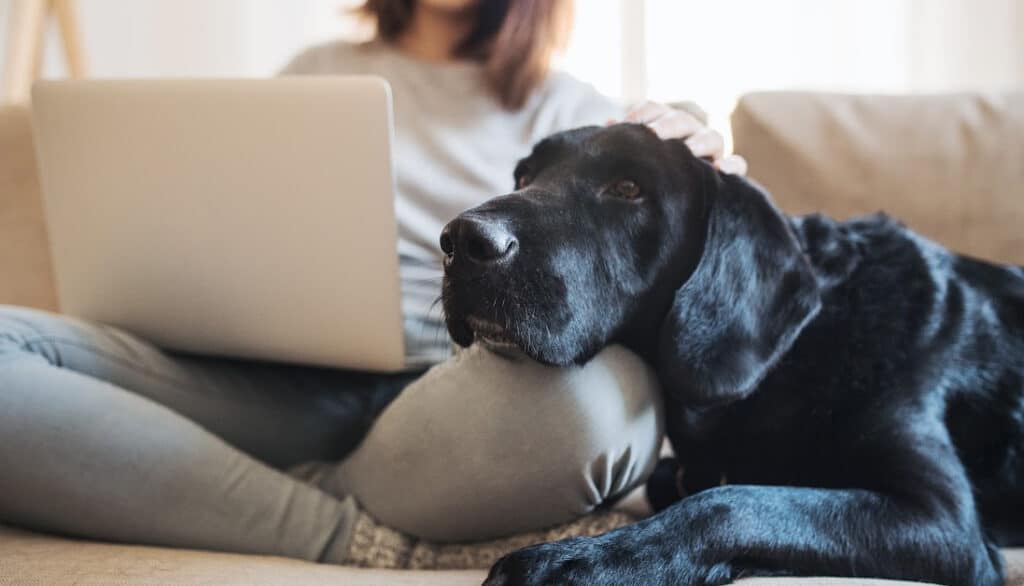
What are Dog Warts and What Causes Them?
Dog warts, scientifically known as canine papillomas, are small, benign growths that can appear on any part of a dog’s body, including the skin, ears, and lips. They are most commonly found in younger dogs, though older dogs with weakened immune systems can also be susceptible.
- Appearance and Texture: Dog warts are typically flesh-colored, though they can sometimes be darker or lighter than the surrounding skin. They often have a rough, cauliflower-like texture and can appear as single growths or in clusters.
- Causes of Dog Warts: The primary cause of dog warts is the Canine Papillomavirus (CPV). This virus has multiple strains, and different strains can cause warts in various parts of the dog’s body. Just like human papillomaviruses in people, CPV is species-specific, meaning it only affects dogs.
- How Dogs Contract CPV: The virus is transmitted through direct contact with an infected dog or with contaminated objects, such as toys, bowls, or bedding. Dogs with open wounds or cuts are more susceptible as these provide an entry point for the virus. Additionally, dogs that frequently socialize with other dogs, like in dog parks or kennels, might be at a higher risk due to increased exposure.
- Immune System’s Role: A dog’s immune system plays a crucial role in warding off the virus. As the immune system matures and strengthens, it often eliminates the virus on its own. This is why younger dogs, with still-developing immune systems, are more commonly affected. However, older dogs with compromised immunity can also develop warts.
While dog warts might look concerning, they are typically harmless growths caused by the Canine Papillomavirus. It’s essential to monitor them and consult with a veterinarian if you notice any sudden changes in size, color, or if they seem to cause discomfort to your pet.
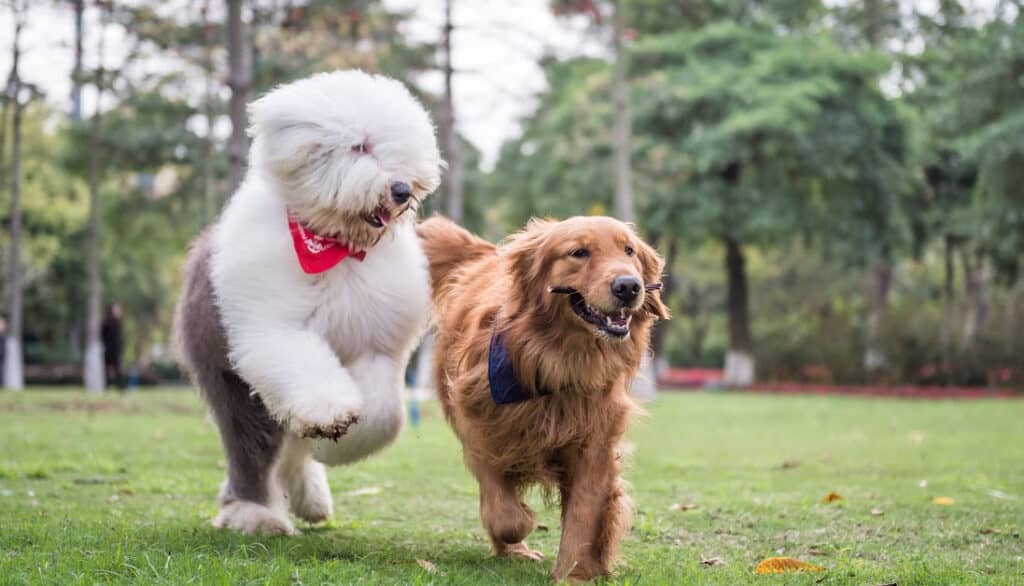
Are Dog Warts Common in Dogs?
Yes, dog warts, or canine papillomas, are relatively common, especially among younger dogs. Their prevalence can be attributed to several factors:
- Age Factor: Puppies and younger dogs are more prone to developing warts because their immune systems are still maturing. As they grow and their immune systems strengthen, they become better equipped to fend off the Canine Papillomavirus, the primary cause of dog warts.
- Social Interactions: Dogs that frequently interact with other dogs, whether at dog parks, grooming salons, kennels, or doggy daycares, have a higher chance of exposure to the virus. These social environments can be hotspots for the transmission of CPV, especially if an infected dog is present.
- Breed Susceptibility: While all breeds can develop dog warts, some breeds might be more predisposed due to genetic factors or specific characteristics of their skin and coat. However, comprehensive research on breed-specific susceptibility is still ongoing.
- Environmental Factors: Dogs living in environments where hygiene is compromised or those exposed to contaminated objects regularly might have a higher risk. This includes shared toys, water bowls, or bedding in multi-dog households or communal settings.
- Immune Health: Dogs with compromised immune systems, whether due to age, underlying health conditions, or medications, can also be more susceptible to developing warts. Their bodies might not fight off the virus as effectively as those with robust immunity.
While dog warts are common, especially in younger canines, they are usually benign and often resolve on their own as the dog’s immune system matures. However, it’s always a good practice for dog owners to be observant and consult with a veterinarian if they notice an unusual growth or if existing warts exhibit concerning changes.
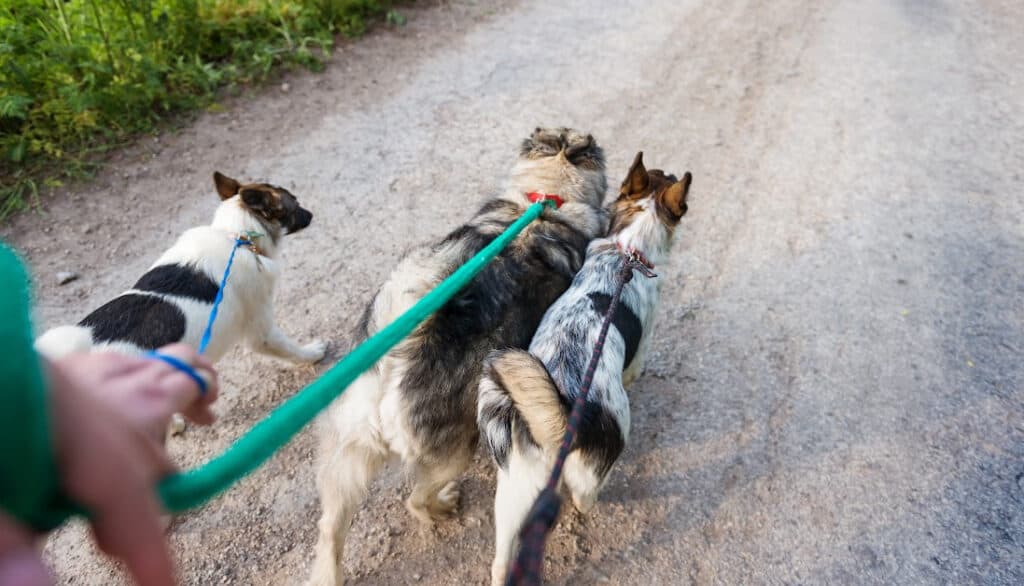
Transmission of Dog Warts: How Do Dogs Get Them?
Understanding the transmission of dog warts is crucial for prevention and management. The primary culprit behind these warts is the Canine Papillomavirus (CPV), and its transmission can occur in various ways:
- Direct Contact with Infected Dogs: The most common mode of transmission is through direct contact with an infected dog. When dogs play, groom each other, or engage in any form of close interaction, the virus can easily spread from one to another, especially if one of them has visible warts.
- Contact with Contaminated Objects: Objects that an infected dog has come into contact with can harbor the virus. This includes toys, bedding, food and water bowls, and grooming tools. When another dog interacts with these contaminated items, they can contract the virus.
- Shared Environments: Places where multiple dogs congregate, such as dog parks, kennels, grooming salons, or doggy daycares, can be hotspots for CPV transmission. The virus can survive in the environment for a short period, making it possible for dogs to get infected even without direct contact with an infected dog.
- Open Wounds or Cuts: Dogs with open sores, wounds, or cuts are at a heightened risk. These openings in the skin can serve as entry points for the virus, especially if they come into contact with an infected surface or dog.
- Mother to Offspring: Though less common, there have been instances where the virus is transmitted from an infected mother to her puppies, either during birth or through close contact afterward.
Prevention and Caution:
While it’s challenging to entirely prevent the transmission of dog warts, certain measures can reduce the risk:
- Regularly disinfecting toys, bedding, and other shared items.
- Monitoring your dog’s interactions in communal settings and ensuring they play with healthy dogs.
- Checking your dog regularly for any signs of warts, especially after they’ve been in a shared environment.
- Consulting with a veterinarian if you notice any warts on your dog, to understand the best care and preventive measures.
While the transmission of dog warts is common due to the nature of dogs’ social behaviors and the environments they frequent, being informed and vigilant can help in managing and reducing the risk of infection.

Are Dog Warts Contagious to People or Other Pets?
The question of contagion is a common concern among pet owners, especially when it comes to conditions like warts that are caused by viruses. Let’s delve into the specifics of the contagious nature of dog warts:
- Contagiousness to Humans: Dog warts, caused by the Canine Papillomavirus (CPV), are species-specific. This means that the strains of the virus that affect dogs do not typically infect humans. So, the direct transmission of dog warts to humans is highly unlikely. However, as with any health concern, it’s always a good practice to maintain hygiene, like washing hands after handling an infected dog or their belongings.
- Contagiousness to Other Dogs: Yes, dog warts are contagious to other dogs. As previously discussed, the virus can spread through direct contact with an infected dog or through shared objects and environments. Younger dogs, or those with compromised immune systems, are particularly susceptible.
- Contagiousness to Other Pets: When it comes to other pets, the risk varies:
- Cats: There’s no evidence to suggest that the Canine Papillomavirus can infect cats. Felines have their own set of papillomaviruses, distinct from those that affect dogs.
- Other Common Pets (birds, rodents, reptiles): These animals are not known to contract the Canine Papillomavirus. Each species typically has its own set of viruses, and cross-species transmission is rare.
Preventive Measures:
While humans are not at risk, if you have multiple dogs or frequently visit communal dog areas, it’s essential to take preventive measures:
- Isolate an infected dog from other dogs until the warts resolve.
- Regularly clean and disinfect shared items and spaces.
- Monitor your dog’s health and consult a veterinarian if you notice any warts or related symptoms.
While dog warts are not contagious to humans or most other pets, they can spread among dogs. Being informed and taking appropriate precautions can help manage and prevent the spread of this condition.
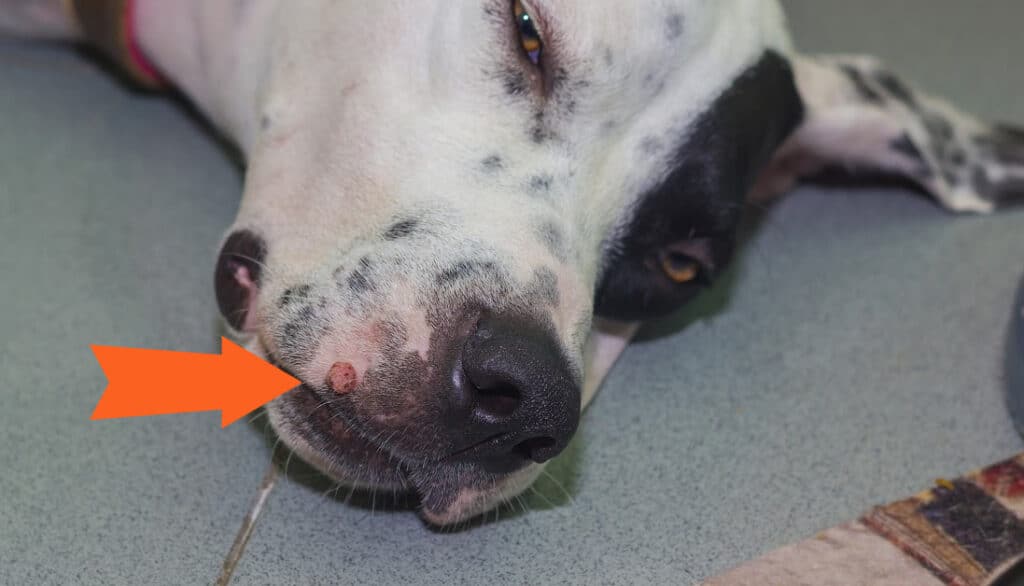
Identifying Dog Warts: Appearance and Symptoms
Recognizing dog warts early on can help in managing them effectively and ensuring the well-being of your pet. Here’s a comprehensive guide on the appearance and symptoms associated with dog warts:
Appearance of Dog Warts:
- Texture and Shape: Dog warts often have a rough, cauliflower-like texture. They can be round or irregular in shape.
- Color: While most dog warts are flesh-colored, they can also appear as white, pink, or even darker shades like brown or black, depending on the dog’s skin color and the type of wart.
- Size: They can vary in size, from tiny pinhead-sized growths to larger, more noticeable warts. Some might even grow to the size of a pea or larger.
- Location: Dog warts can appear anywhere on the body. Common areas include the face, lips, inside of the mouth, ears, paws, and the belly. They can appear as solitary growths or in clusters.
Symptoms Associated with Dog Warts:
While many dog warts are benign and might not cause any discomfort, some can lead to noticeable symptoms:
- Irritation or Itchiness: Dogs might scratch, bite, or lick the wart, especially if it’s in an accessible location like the paws.
- Bleeding: If a wart is injured or scratched excessively, it might bleed.
- Swelling or Inflammation: Surrounding areas might become red and swollen, especially if the dog is constantly irritating the wart.
- Difficulty Eating: Warts inside the mouth or on the lips can make it challenging for the dog to eat or drink, leading to drooling or a loss of appetite.
- Secondary Infections: If a wart is injured, there’s a risk of bacterial infections, which can exacerbate the symptoms.
Differentiating from Other Skin Growths:
It’s essential to differentiate dog warts from other skin growths or conditions, such as skin tags, cysts, tumors, or fungal infections. While the appearance can give some clues, a definitive diagnosis often requires a veterinary examination. In some cases, a biopsy might be recommended to rule out malignancies.
Identifying dog warts is the first step towards effective management and treatment. If you notice any unusual growths or symptoms in your dog, it’s always best to consult with a veterinarian. They can provide a definitive diagnosis and recommend appropriate treatment options, ensuring your dog’s comfort and health.
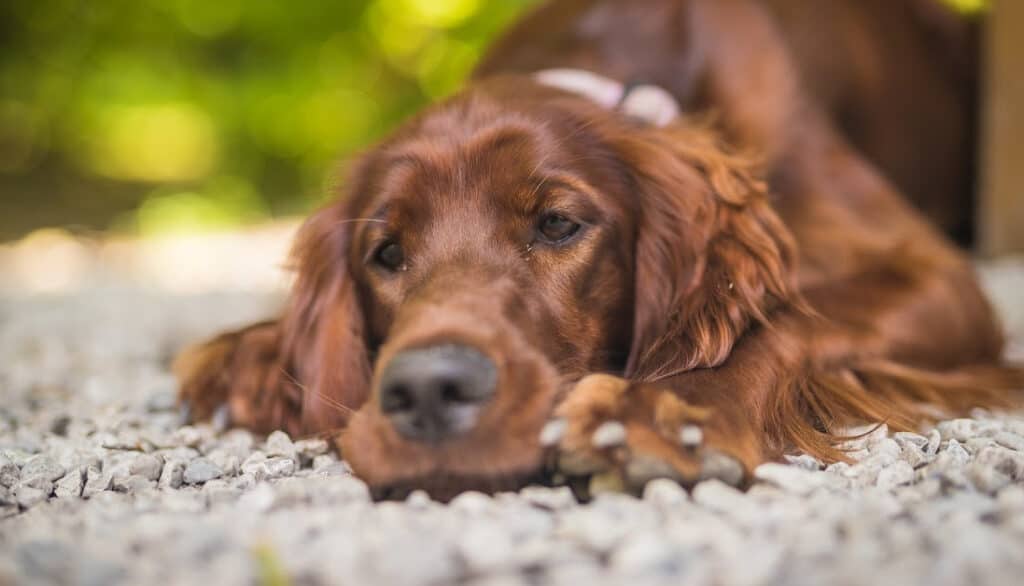
How Long Do Dog Warts Last in Dogs?
The duration of dog warts can vary based on several factors, but understanding the general timeline can help pet owners set expectations and manage the condition more effectively.
Typical Duration:
Most dog warts, especially in younger dogs, will eventually go away on their own as the dog’s immune system responds to the Canine Papillomavirus (CPV) causing the warts. On average, dog warts last anywhere from a few weeks to several months. However, it’s not uncommon for some warts to persist for a year or longer, especially in older dogs or those with compromised immune systems.
Factors Influencing Duration:
- Age of the Dog: Younger dogs, with their still-maturing immune systems, might take a bit longer to clear the virus and the warts. As they age and their immune response strengthens, the duration can shorten.
- Immune Health: Dogs with robust immune systems tend to recover faster. Conversely, those with weakened immunity, whether due to age, underlying health conditions, or certain medications, might experience prolonged wart presence.
- Number and Location of Warts: A single wart might resolve faster than clusters. Warts in areas that the dog frequently irritates (by scratching, biting, or licking) might take longer to heal and can even become secondary infection sites.
Accelerating Recovery:
While many dog warts will resolve without intervention, some treatments can potentially speed up the process:
- Immune Boosters: Some veterinarians might recommend immune-boosting supplements or medications to help the dog’s body fight off the virus more effectively.
- Topical Treatments: Certain creams or ointments can be applied to reduce the size of the wart and stimulate healing. Always consult with a veterinarian before applying any product.
- Surgical Removal: In cases where the wart is causing significant discomfort, is at risk of frequent injury, or is in a problematic location (like inside the mouth), a veterinarian might recommend surgical removal.
While dog warts can be a source of concern for many pet owners, it’s comforting to know that they are typically temporary and often resolve as the dog’s immune system matures and combats the virus. Monitoring the warts, ensuring they don’t become infected, and consulting with a veterinarian for guidance are essential steps in managing this common canine condition.
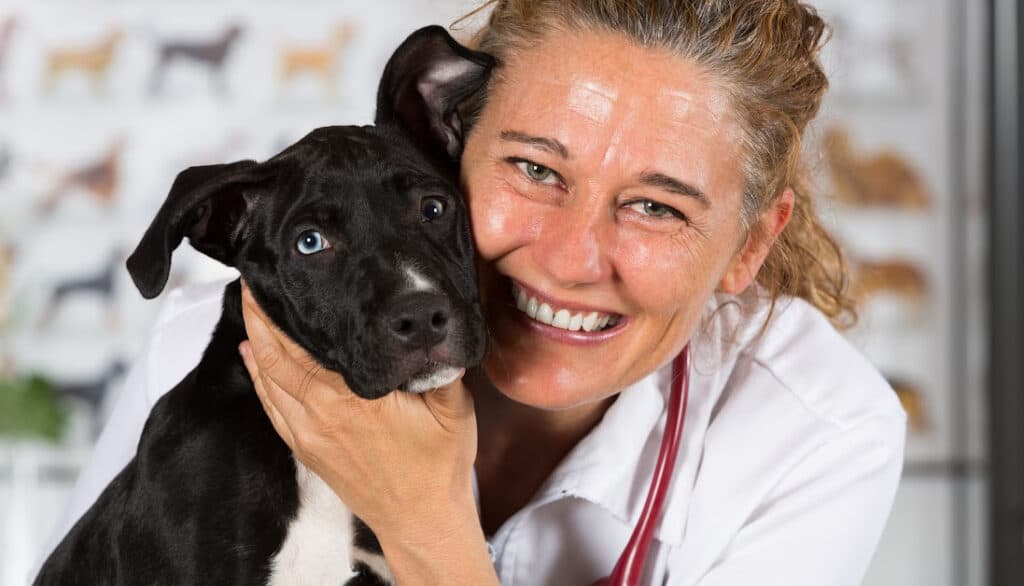
Are Dog Warts in Dogs Dangerous?
Dog warts, or canine papillomas, often raise concerns among pet owners. While they might appear unsettling, it’s essential to understand their nature and potential risks.
Typically Benign:
The majority of dog warts are benign growths caused by the Canine Papillomavirus (CPV). This means they are non-cancerous and, in most cases, don’t pose a significant health threat to the dog.
Potential Complications:
While dog warts themselves are usually harmless, certain situations can elevate the risk:
- Secondary Infections: If a dog frequently scratches, bites, or licks a wart, it can become injured and susceptible to bacterial infections. An infected wart might become red, swollen, ooze pus, and be painful to the touch.
- Location of the Wart: Warts inside the mouth or on the lips can interfere with eating and drinking. If a dog has multiple warts in the oral cavity, it might drool excessively, lose appetite, or show signs of discomfort while eating.
- Growth and Multiplication: In rare cases, a sudden increase in the size of a wart or the rapid appearance of multiple warts can indicate an aggressive strain of the virus or an underlying immune system issue.
Differentiating from Other Growths:
It’s crucial to ensure that what’s identified as a wart is indeed a wart. Other skin growths, like cysts, tumors, or skin tags, can sometimes resemble warts. If there’s any doubt about the nature of the growth, a veterinarian might recommend a biopsy to rule out malignancies or other skin conditions.
Monitoring and Veterinary Consultation:
Regularly inspecting the warts is essential. If you notice any of the following changes, it’s time to consult a veterinarian:
- Rapid increase in size.
- Change in color or appearance.
- Signs of infection, like redness, swelling, or discharge.
- Any behavior in the dog indicating pain or discomfort.
While dog warts are typically not dangerous, they require observation and care. Being proactive in monitoring their appearance and seeking veterinary advice when needed ensures that any potential complications are addressed promptly, keeping your canine companion in the best of health.
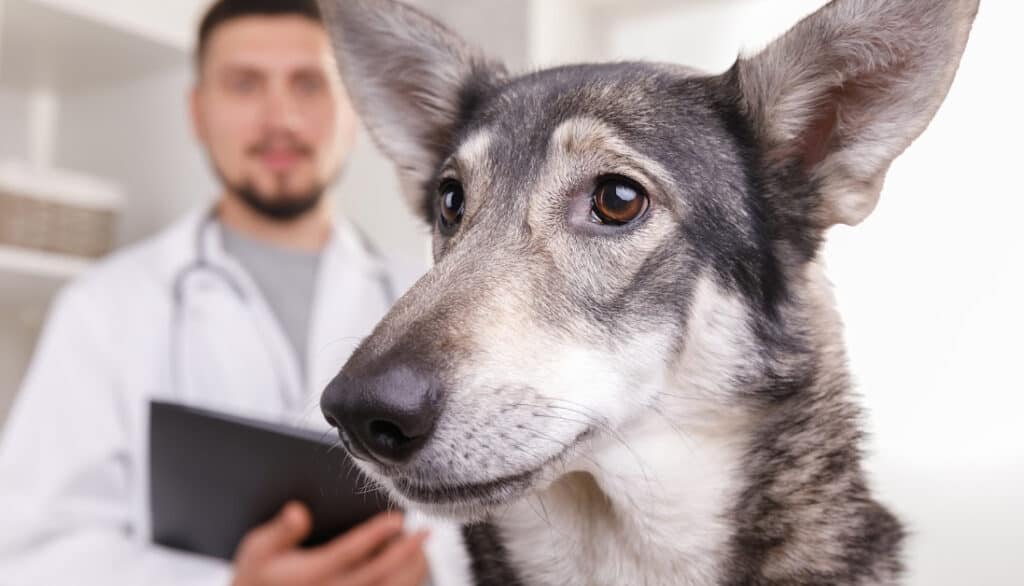
Treatment Options for Dog Warts in Canines
Addressing dog warts effectively requires a combination of veterinary expertise and, in some cases, proactive home care. Here’s a comprehensive guide on the available treatment options for dog warts:
Watchful Waiting:
Given that many dog warts resolve on their own as the canine’s immune system combats the virus, a common approach is simply to monitor the warts without immediate intervention. This is especially true for warts that aren’t causing discomfort or posing any risk of secondary infections.
Topical Treatments:
There are several topical solutions that can be applied directly to the wart:
- Salicylic Acid: Available in various over-the-counter preparations, it can help reduce the size of the wart. However, it’s essential to consult with a veterinarian before application.
- Imiquimod Cream: An immune response modifier that can be prescribed by veterinarians for certain types of warts.
Surgical Removal:
For warts that are problematic due to their location, size, or risk of injury, surgical removal might be recommended:
- Traditional Surgery: The wart is excised using surgical tools under local or general anesthesia.
- Cryosurgery: This involves freezing the wart using liquid nitrogen, causing it to fall off after some time.
- Laser Surgery: A high-intensity laser is used to remove the wart, often with minimal bleeding and a reduced risk of infection.
Electrocautery:
This method uses electrical current to burn off the wart. It’s a quick procedure, usually done under local anesthesia.
Home Remedies and Natural Treatments:
While there are various home remedies touted for treating dog warts, such as applying castor oil, vitamin E, or even apple cider vinegar, their efficacy is anecdotal. It’s crucial to consult with a veterinarian before trying any home remedy to ensure it’s safe and won’t cause further complications.
The appropriate treatment for dog warts depends on their size, location, number, and any associated symptoms or complications. While many warts don’t require aggressive treatment, it’s essential to consult with a veterinarian to determine the best course of action for your canine companion’s specific situation.
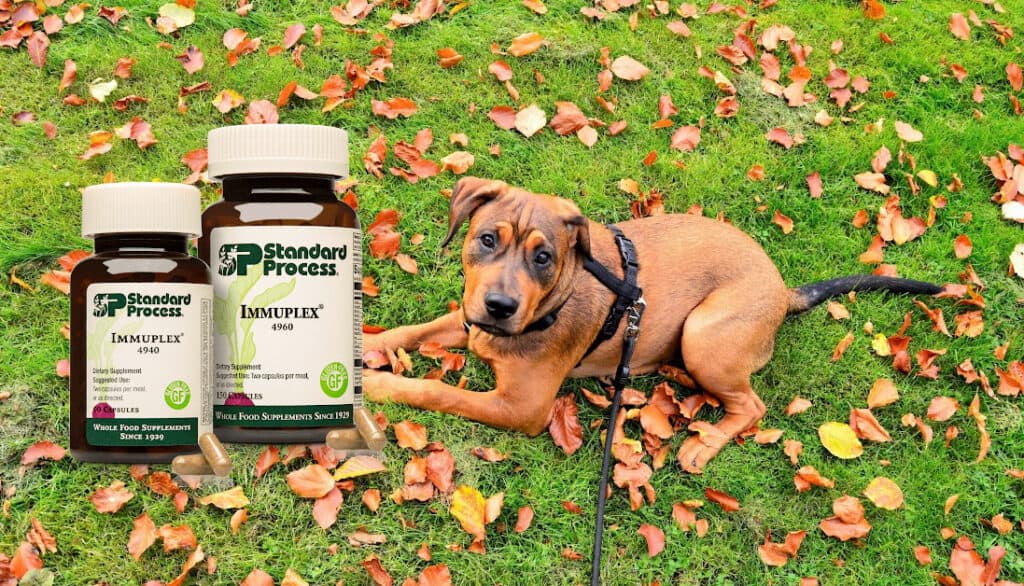
Standard Process Immuplex for Treating and Preventing Dog Warts
In the realm of holistic veterinary medicine, we often look to whole-food supplements to support the body’s natural healing processes. One such supplement that has garnered attention for its potential benefits in treating and preventing dog warts is the Standard Process Immuplex.
1. What is Standard Process Immuplex?
Standard Process Immuplex is a whole-food supplement designed to support the body’s immune system. It blends essential nutrients from various sources, such as spleen, thymus, and liver extracts, along with vitamins and minerals, to provide comprehensive immune support.
2. How Can It Help with Puppy Warts?
- Immune System Boost: The primary cause of dog warts is the Canine Papilloma Virus (CPV). A robust immune system can combat this virus more effectively, reducing the appearance and duration of warts. Immuplex is designed to bolster the immune system, making it a potential ally in the fight against CPV.
- Nutrient-Rich Composition: The blend of vitamins, minerals, and glandular extracts in Immuplex provides a holistic approach to health, ensuring that the body has the necessary nutrients to function optimally.

3. How to Use Standard Process Immuplex for Dog Warts?
- Dosage: The dosage will vary based on the puppy’s weight and overall health. It’s crucial to consult with a holistic veterinarian to determine the appropriate dosage for your dog.
- Duration: For preventive measures, a short course might be recommended. However, for treating existing warts or other immune-related issues, a longer course might be necessary.
- Administration: Immuplex usually comes in capsule form. The capsule can be opened, and the contents mixed with the dog’s food for easier administration.
4. Precautions and Considerations
- Consultation: Always consult with a holistic veterinarian before introducing any new supplement to your dog’s regimen.
- Monitor for Reactions: While adverse reactions are rare, it’s essential to observe your puppy for any changes in behavior, digestion, or overall health after starting the supplement.
- Quality Matters: Ensure that you’re purchasing the genuine Standard Process Immuplex from a reputable source to guarantee its quality and efficacy.
Standard Process Immuplex offers a natural approach to bolstering the immune system, making it a potential tool in treating and preventing dog warts. As with any supplement or treatment, individual results may vary, and it’s essential to approach its use with knowledge and guidance from a trusted
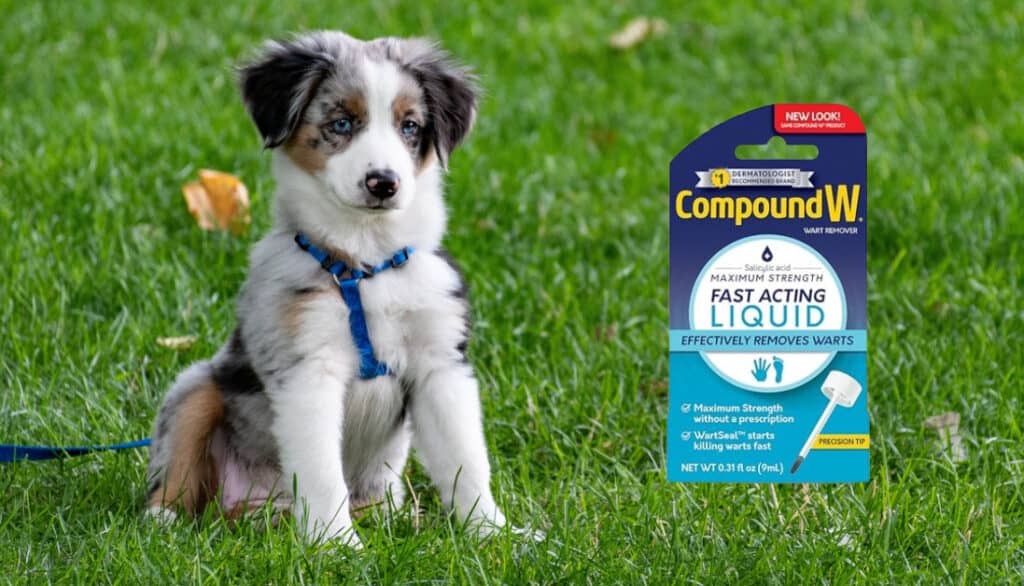
Can I Use Compound-W® for My Dog’s Warts?
Compound-W® is a popular over-the-counter treatment for human warts, primarily containing salicylic acid. When it comes to our furry friends, the question of its safety and efficacy arises. Let’s delve into this topic:
1. Salicylic Acid and Dogs: Salicylic acid, the active ingredient in Compound-W®, works by causing the cells of the epidermis to shed more readily, preventing pores from clogging up, and allowing room for new cell growth. While it can be effective in treating human warts, its use in dogs is not as straightforward.
2. Potential Risks:
- Irritation: Dogs have different skin pH levels and sensitivities compared to humans. Applying Compound-W® might cause skin irritation, redness, or even burns in some dogs.
- Ingestion: Dogs are notorious for licking treated areas, and ingesting salicylic acid can be harmful. Symptoms of salicylic acid poisoning in dogs include vomiting, diarrhea, rapid breathing, and lethargy.
- Ineffective Treatment: Even if the product doesn’t harm the dog, it might not be effective in treating the wart, leading to prolonged discomfort for the pet.
3. Veterinary Recommendations: Before using any human medication or treatment on a dog, it’s imperative to consult with a veterinarian. They can provide guidance on whether Compound-W® is suitable for your dog’s specific situation or recommend alternative treatments that are safer and more effective for canine warts.
4. Alternatives to Compound-W®: If your veterinarian advises against using Compound-W®, there are other treatments they might recommend:
- Veterinary-Formulated Topical Treatments: These are designed specifically for dogs, taking into account their skin pH and sensitivities.
- Surgical or Laser Removal: For problematic warts, your veterinarian might suggest a more direct approach to removal.
- Immune-Boosting Supplements: Enhancing the dog’s immune response can help in naturally combating the wart virus.
While it might be tempting to use readily available human treatments like Compound-W® for our pets, it’s crucial to prioritize their safety and well-being. Always consult with a veterinarian before applying any medication or treatment to ensure it’s the right choice for your canine companion.
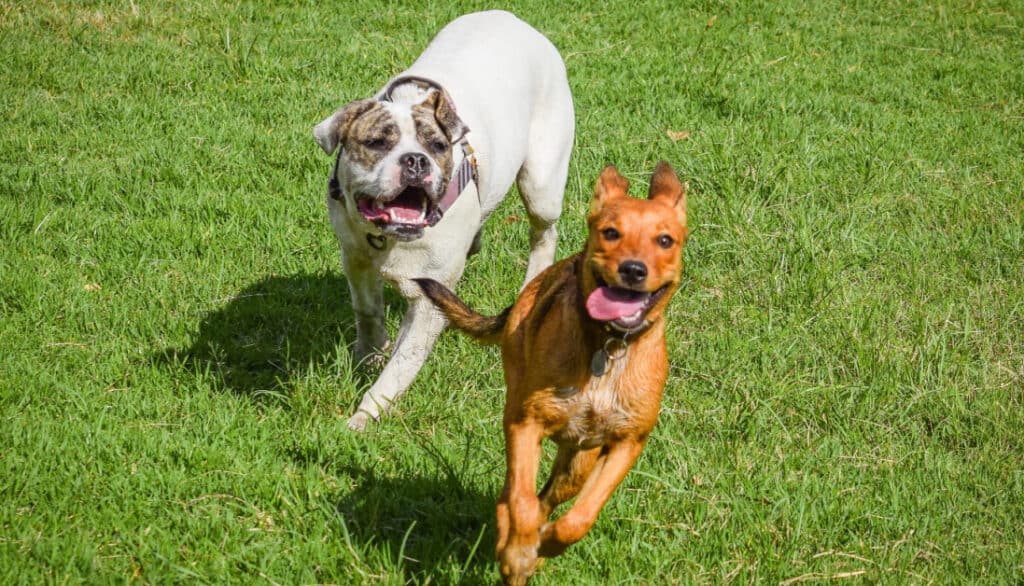
Conclusion
Dog warts, while common and typically benign, can be a source of concern for many pet owners. As we’ve navigated through the various facets of this condition, from identification to treatment options, it’s evident that understanding and knowledge are our best allies. Armed with this information, you can approach any wart-related issue with confidence and clarity.
Remember, while there’s a wealth of information available, your veterinarian remains an invaluable resource. They can provide personalized advice, tailored treatments, and the peace of mind that comes from professional expertise.
In the end, our dogs rely on us for their well-being. By staying informed and proactive, we can ensure they lead comfortable, happy lives, wart-free or otherwise. Thank you for joining me on this journey of understanding dog warts. Here’s to the health and happiness of our four-legged companions!
Frequently Asked Question
Dog warts, or canine papillomas, are benign growths caused by the Canine Papillomavirus (CPV). While they share similarities with human warts, which are caused by the Human Papillomavirus (HPV), the two are species-specific. This means the virus strains that affect dogs do not typically infect humans and vice versa.
While the appearance of dog warts can give some clues, a definitive diagnosis often requires a veterinary examination. In some cases, a biopsy might be recommended to rule out other skin conditions or growths.
While there are anecdotal reports of home remedies like apple cider vinegar or castor oil being effective, it’s essential to consult with a veterinarian before trying any home treatment. Some remedies might not be safe for dogs or could cause further complications.
Not necessarily. While a robust immune system can help combat the virus causing the warts, even healthy dogs can develop warts, especially younger ones. Puppies and younger dogs are more prone to warts as their immune systems are still maturing.
Most dog warts are benign and don’t pose a significant health risk. However, it’s essential to monitor them and consult with a veterinarian if you notice any sudden changes in size, color, or if they seem to cause discomfort to your pet. In rare cases, growths that resemble warts might be malignant, so professional evaluation is crucial.
